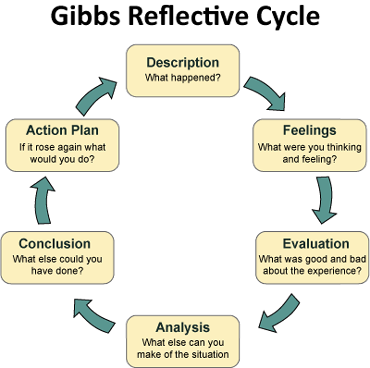A Teacher’s Corner
“It is not sufficient simply to have an experience in order to learn. Without reflecting upon this experience, it may quickly be forgotten, or its learning potential lost.” (Boud, Keogh & Walker, 19).

Before beginning placement it was important for me to read some reflective teaching materials that will prepare how I can effectively contribute to lessons to help pupils’ cognitive growth. Using Gibbs’ Reflective Cycle (1988) I will reflect on my initial experience in Carhill Integrated Primary School where I was responsible for explaining class work to the primary 2 pupils, and was instructed by the class teacher to use the iPad and go on the ‘Top marks’ website to watch a video and discuss an activity where they had to fill in missing letters for 3 letter words.
At the time of teaching, I was thinking and reflecting on the fact that this was my first time properly teaching and I felt a little intimidated but, it was also very exciting because it was different from the previous responsibilities I was given in past placements.
Something good that went well was that I became more comfortable and confident as I started using words of encouragement and praise that sustained their engagement with the task as they became very eager to tap missing letters on the iPad. Successfully, I made sure we were all sat in a circle to ensure everyone was able to see the iPad as I was aware that effective teaching means pupils have to be able to see, thus adding to my reflection. Taking Green’s ‘pedagogic knowledge’ into account which is techniques you learn through teaching that will help minimise learning from being affected, along with a phrase I heard from the class teacher that really stood out and helped my reflective learning was, “If I can see you, you can see me,” which became one of the key things I looked out for when teaching pupils as it really helped my awareness of how visible I am to them, and if I cannot see some pupils then I need to move some where, where they can see me so that learning is not affected.
Furthermore, I noticed a pupil mumbling a few incoherent words, copying the answers of her peers sitting next to her and another thing that was not as good was the lack of good behaviour;
iPad + Children = CHAOS o___O
As time passed, pupils became overly energetic as they jumped out of their seats eagerly trying to gain my attention so that I will pick them to fill in the next missing letter on the iPad. They reacted loudly and ignored the sitting quietly with their hand up rule. Big reactions from young children like this are inevitable but it did caught me off guard as the noise increased significantly when I was flooded with eager, “Me! Me! I know it!” and “I want to answer that one!” speaking together all at once. I incorporated a past teaching method I observed before and used it to my advantage; so I remained silent with my arms folded, keeping a straight face until they realised my posture and dissolved their noise. I then picked the pupil who was sitting quietly with their hand up and took the opportunity to say, “Wow, look at how nice and quiet (pupil) is sitting, waiting for me to pick them,” and this worked really well as their peers started to copy and follow the praised pupil’s behaviour.

Reflecting back on my vocabulary choices of the positive adjectives, “nice” and “quiet” combined with a proud tone, I think this was a positive experience as it was effective in helping me identify how effective my method was. I learned that by praising one pupil’s good actions, the rest will have no choice but to follow and I did not have to use the ‘telling off’ approach. Beforehand, I read Dewy’s ‘second reflective process’ which explains how bonds and connections in an experience helps aid reflective learning, (12) which reflects how successful I was at managing behaviour by saying positive language in a happy voice to maintain this connection.
Furthermore, I asked the pupil who was not as confident in answering on her input, encouraging individual thinking which now, reflecting back I will take Heilbronn’s reading of ‘practical judgement’ into account next time as it explains how one should “respond flexibly and appropriately” (Colwell & Pollard, 14). This helped me realise that her lack of individual participation may indicate more support is required and something else I could have done was to give some hints to aid her thinking. If this was to happen again I will go over some basic phonics first before I begin teaching as revision can stimulate the brain’s development. Moreover, I could have identify the pupil who needed more guidance earlier by randomly picking pupils to complete the words, and this would have prevented teaching time from being lost, as the time could have been spent going over more examples and I will remember this next time.
Overall, a reflection from this experience was that I learned how effective my teaching skills were and the importance of tone and vocabulary as a bubbly voice made pupils more inclined to listen to me, co-operate and participate more thus, performing better in their work. I also learned how to maintain a healthy bond with the pupils and recognised where improvements can be made. Bennett talks about how, “as a teacher…you might be asked to perform duties that range from the academic to…making sure children are happy,” (20) which is very relatable to my reflective learning as I feel more confident and ready to use the reflective solutions I learned for future teaching tasks. For the time being, I will read more materials to help improve my teaching and reflect on my own methods and self-development.
Pages: 1 2
Confidence is Key
You May Also Like

Roles Reversed
26 November 2021
First Day Fears
24 November 2021

